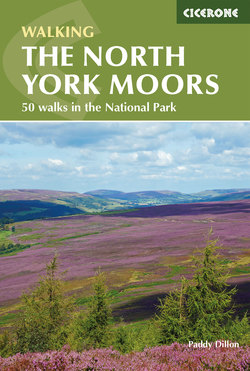Читать книгу The North York Moors - Paddy Dillon - Страница 12
На сайте Литреса книга снята с продажи.
ОглавлениеWALK 2
Hackness, Broxa and Whisper Dales
| Start/finish | Hackness Village Hall, SE 967 900 |
| Distance | 9.5km (6 miles) |
| Total ascent/descent | 200m (655ft) |
| Time | 3hrs |
| Terrain | Tracks and paths on wooded slopes and through fields |
| Maps | OS Landrangers 94 and 101; OS Explorer OL27 South |
| Refreshments | Hackness Grange Hotel is near the start |
| Transport | None |
Hackness is a charming little village with a long history – the Abbess Hilda of Whitby chose a secluded site here to found a nunnery. A few quiet, charming and often unregarded little dales fan outwards from the village into surrounding forest, a couple of which are explored on this short walk. The route starts with a climb on to broad, cultivated Broxa Rigg, with a descent to Hard Dale and High Dales. After crossing Springwood Heights, the route continues through Whisper Dales, a sinuous grassy valley leading down to Low Dales on the return journey to Hackness.
Starting at Hackness Village Hall, walk up the road as if heading for the rest of the village, then double back sharp left up a track on a wooded slope. Keep right at a track junction to reach a grassy crest. Continue alongside Chapman Banks Wood for a while, then drift right to the other side of the vegetated crest, to locate a small gate hidden in a far corner. Go through the gate and keep to the edge of a field beside another wood, at around 160m (525ft). Look ahead to spot step-stiles from field to field and always keep to the edge, beside the wood. In the last field, aim for a farmhouse and go through a gate to reach a road.
Keep right of the buildings at Broxa to follow the farm road. Turn right and continue along a narrow, tarmac, muck-and-manure road, passing a public footpath sign and heading in the direction of Broxa Forest. However, before reaching the forest, turn right as directed by another public footpath sign and walk across a field. Cross a step-stile among nettles into Fewler Gate Wood and follow a path down through a little wooded valley. Head right at the bottom, but watch for a stile on the left and step out into a field in Hard Dale. Go down to a stream and cross it, as indicated by a public footpath signpost. Walk uphill and turn left along a farm road.
Just as a house is reached at Newgate, turn right uphill as indicated by a public footpath sign. Climb a grass-and-gorse bank, then enter a forest and turn left behind the house. Turn right steeply uphill and cross an old forest track to climb further. Leave the forest and walk alongside a field, continuing beside another stand of forest, at around 160m (525ft). Veer right along a very vague field path to go down into another wood. Watch carefully for markers as some parts of the path are overgrown, especially when it is necessary to keep to the left-hand side of a fence. Step out into a field and head diagonally down it to reach a grassy track in Whisper Dales beside a stream flanked by trees.
The grassy track running downhill from Whisper Dales towards Low Dales
Turn right to follow the grassy track down into Low Dales. It remains grassy and is marked by arrows for a while. Cross two footbridges beside two fords close together at Lowdales Farm. Follow a field path to the left of the road, as the road actually carries the full flow of water from Lowdales Beck! Continue to follow the path down through the dale to reach a junction. Left leads to St Peter’s Church in Hackness, while right leads back to the road junction at the village hall, not far from the Hackness Grange Hotel.
HACKNESS
St Hilda founded a nunnery at Hackness in AD680, but even in this secluded setting it was discovered and plundered by the Danes in AD867, then rebuilt in the 11th century. An inscribed cross from the nunnery is located in St Peter’s Church, but the only other reminder of those times is the village pond. Hackness is very much an estate village, and its main street is peculiar, as it has a vigorous stream running alongside it. Hackness Hall is a fine Georgian manor designed by John Carr, an architect from York. The hall is in the possession of Lord Derwent.
Hackness Hall and Hackness village lie just off-route
